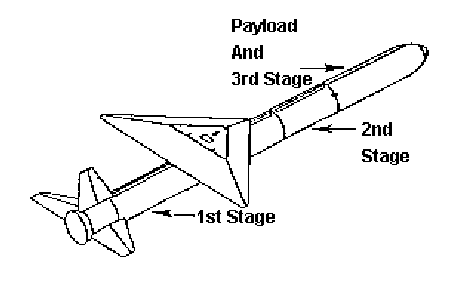| |
Aerodynamic Support
NEAR Aerodynamic Support of Pegasus (TM)
|
Pegasus(TM), a three-stage, air-launched, winged space booster was developed to provide fast and efficient commercial launch services for small satellites. The objective of this privately financed program between Orbital Sciences Corporation and Hercules Aerospace Company was to provide reliable space launch services at a low cost on near-term schedule. The aerodynamic design and analysis of Pegasus was conducted by NEAR without benefit of wind tunnel or flight tests using only computational aerodynamic and fluid dynamic methods.
|
 |
The aerodynamic design and analysis was based on proven, state-of-the-art, readily available computational codes. Additional considerations in the aerodynamic design philosophy were code availability, ease of use, engineering capability, and confidence level. Since no wind tunnel data on Pegasus were available for guidance, a high degree of confidence in the prediction methods was required to avoid a great amount of time spent validating the selected codes. The overall objective of the Pegasus aerodynamic analysis was to use the highest level code required for a specific task. |
 |
|
The aerodynamic analysis and support considered a number of different technical areas such as trajectory requirements, aerodynamic loading distributions, stability and control, and aerodynamic heating. The flight conditions included carriage and launch from the B-52 parent aircraft, transonic flight at high angles of attack, supersonic flight over the complete angle-of-attack range, and hypersonic flight to first-stage burnout. For this entire flight regime, it was necessary to select and validate appropriate prediction methods from the best technology available and estimate the level of accuracy achieved. The computational techniques ranged from engineering methods (empirical/database/theoretical codes) to computational fluid dynamics (CFD) methods. Economics, accuracy, and schedule were under constant consideration during the computational aerodynamic analyses.
The correlation of measured and predicted forces and moments from the first two flights of Pegasus served to demonstrate the feasibility of the chosen computational approach for design and analysis purposes. NEAR is available to provide fluid mechanics consulting using the latest advanced technology.
|
References:
- Mendenhall, M. R., Lesieutre, D. J., Caruso, S. C., Dillenius, M. F. E., and Kuhn, G. D., "Aerodynamic Design of Pegasus: Concept to Flight with CFD," AGARD CP-493, Missile Aerodynamics, Oct. 1990, p. 7-1 - 7-11; also, AIAA 91-0190, Jan. 1991; also Journal of Spacecraft and Rockets, Vol. 31, No. 6, Nov.-Dec. 1994, pp. 1007-1015.
- Mendenhall, M. R., Lesieutre, D. J., and Whittaker, C. H., "Aerodynamic Analysis of Pegasus - Computations vs Reality," AIAA 93-0520, Jan. 1993.
- Mendenhall, M. R., Lesieutre, T. O., Lesieutre, D. J., and Dillenius, M. F. E., "Carriage and Launch Characteristics of the Pegasus Air-Launched Space Booster," AIAA 94-1910, Jun. 1994; also AGARD CP 570, AGARD Symposium on Aerodynamics of Store Integration and Separation, Ankara, Turkey, 24-28 Apr 1995.
- Mendenhall, M. R. and Lesieutre, D. J., "Pegasus XL Stage 1 Stability Margins," NEAR TR 478, Nielsen Engineering & Research, Mountain View, CA, Apr. 1994.
- Rhode, M. N., Engelund, W. C., and Mendenhall, M. R., "Experimental Aerodynamic Characteristics of the Pegasus Air-Launched Booster and Comparisons with Predicted and Flight Results," AIAA 95-1830, Jun. 1995.
- Mendenhall, M. R., "Pegasus Aerodynamic Control Effectiveness," NEAR TR 501, Nielsen Engineering & Research, Mountain View, CA, Oct. 1995.
- Mendenhall, M. R., Lesieutre, T. O., Lesieutre, D. J., and Dillenius, M. F. E., "Carriage and Release Aerodynamics of the Pegasus Air-Launched Space Booster," AGARD CP-570, Aerodynamics of Store Integration and Separation, Feb. 1996, pp. 11-1 - 11-12.
- Mendenhall, M. R., Hegedus, M. C., and Love, J. F., "Aerodynamic Analysis of the Deep-Stall Flight Characteristics of the Pegasus XL and X-34 Configurations," NEAR TR 516, Nielsen Engineering & Research, Mountain View, CA, Dec. 1996.
- Mendenhall, M. R., Hegedus, M. C., Budd, G. D., and Frackowiak, A. J., "Aerodynamic Analysis of the Deep-Stall Flight Characteristics of the Pegasus XL and X-34 Configurations," AIAA 97-3583, Aug. 1997.
- Mendenhall, M. R., Chou, H. S. Y., and Love, J. F., "Computational Aerodynamic Design and Analysis of Launch Vehicles," AIAA 2000-0385, Jan. 2000.
- Mendenhall, M. R., "An Assessment of Air-Launch Concepts," NEAR TR 597, Nielsen Engineering & Research, Mountain View, CA, Aug. 2003.
AERODYNAMICS and HYDRODYNAMICS
Aerodynamics Support
Missile Preliminary Design Studies
Missile Aerodynamic Loads Analysis
Launch Vehicle Aerodynamic Design and Analysis
Aircraft Store Separation and Carriage Loads Analysis
Unsteady Aircraft Aerodynamics
Maneuvering Submersible Hydrodynamic Analysis
|
|
|

|





